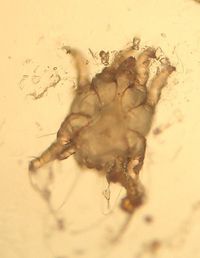Difference between revisions of "Otodectes cynotis"
Jump to navigation
Jump to search
| Line 44: | Line 44: | ||
**These may be asymptomatic carriers | **These may be asymptomatic carriers | ||
[[Category:Non-Burrowing_Mites]][[Category:Dog]] | [[Category:Non-Burrowing_Mites]][[Category:Dog]] | ||
| − | [[Category:To_Do_- | + | |
| + | [[Category:To_Do_-_AimeeHicks]] | ||
Revision as of 06:48, 11 July 2010
- Causes otodectic skin infestation
- Commonest mange of dogs and cats in the world
- Inhabits the inner ear
- Also found in the fox and the ferret
- Closed keratinous bars (apodemes) on ventral surface
- Life cycle takes 3 weeks
- Feeds on ear debris
Pathogenesis
- The majority of cats harbour the mites, however only a few show symptoms
- Transmission occurs whilst kittens are suckling
- Common cause of otitis externa in dogs
- Brown waxy exudate produced
- Can lead to secondary infection
- Clinical signs are apparent
- Head shaking
- Ear scratching
- Aural haematomata
Treatment
- Acaracidal ear drops
- Massage base of ear to disperse drops after treatment
- Most treatments need to be repeated in 10-14 days to kill newly hatched mites
- Selamectin can be used as a spot-on treatment
- Prolonged duration of action
- Treat all in-contact animals
- These may be asymptomatic carriers
